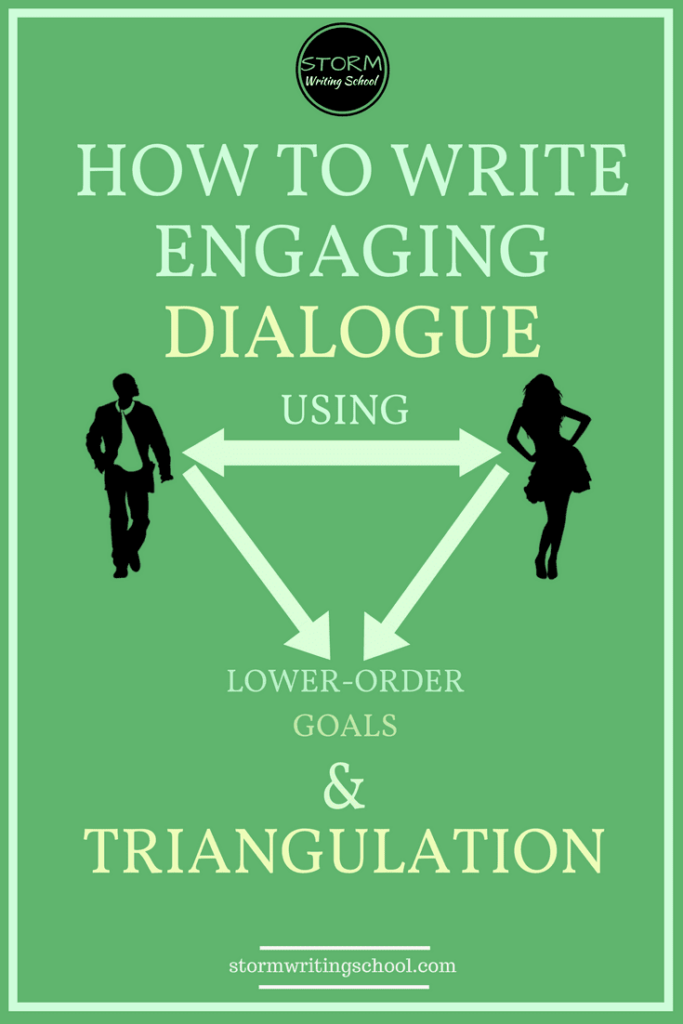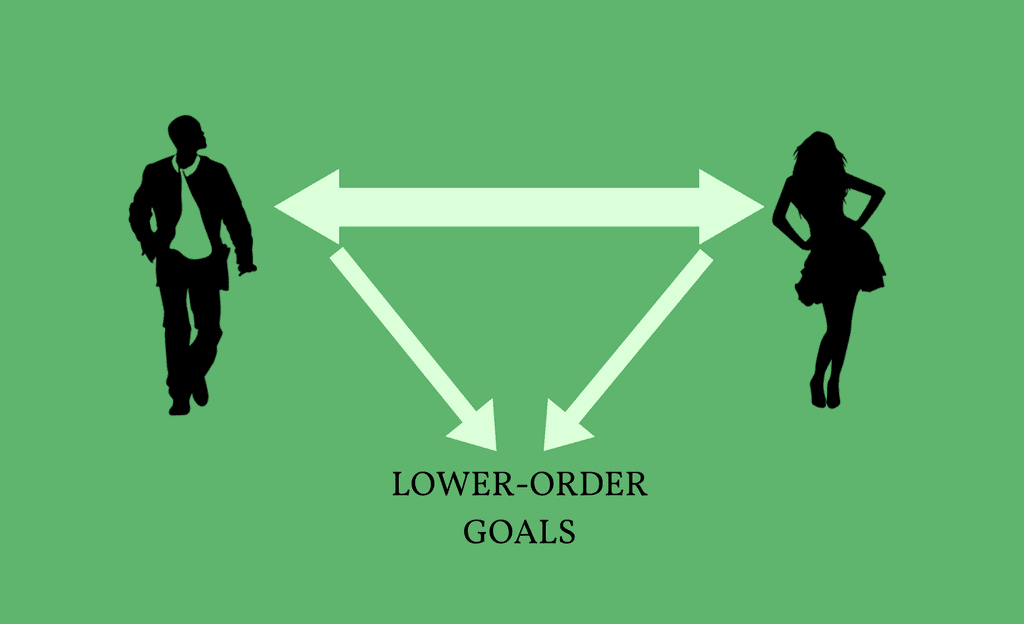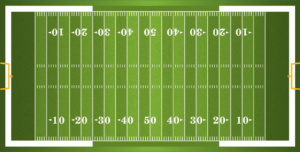How to triangulate dialogue for richer, more engaging scenes.
Here’s what I cover in this article:
- The challenges of dialogue scenes in a nutshell
- Punctuation
- Rendering speech
- Stage business
- The three challenges with stage business
- Triangulation to the rescue
- Lower-order goals
- Examples of triangulation
- So what?
[thrive_leads id=’2890′]
Dialogue scenes pose many challenges
First of all, there’s the punctuation. I can’t tell you how often I end up making small corrections to the punctuation of dialogue in stories and books I edit.
(If dialogue punctuation troubles you, take a look at this guide here, which breaks down all the rules and conventions for punctuating dialogue in American English manuscripts.)
Secondly, there’s the speech itself. You don’t want the “spoken” words to be exactly like real speech, but you also don’t want to get too close to written rendering, lest it sound inauthentic, wooden, or just too damn articulate.
You want to strike a balance between, “Uh, you know, like, how people, uh, really talk, like real-life talk,” and “The manner in which wordings and phrasings are rendered when one puts ink to paper.”
Thirdly, there’s the between-the-lines stuff. What are your characters doing other than talking to one another? I refer to this as stage business, a term taken from theater, and defined as “incidental activity performed by an actor for dramatic effect.”
In short, stage business refers to the actions, gestures, and behavior of the characters during a dialogue interaction. Some refer to it as “action beats.”
What’s so hard about stage business?
Writers can end up falling into one of these traps:
- Use stage business only for rhythmic effect, to pause the language to let a line of dialogue carry more weight.
- Resort to stock gestures and cliched actions.
- Create meaningless background action, (often ostensibly to “characterize”).
Here’s an example of a scene that does all of the above. It’s literate, but amateur:
Sara found Jerzy in the mess hall, finishing off a bowl of stew. “You’re leaving, aren’t you?” she said.
Jerzy set his spoon down beside the bowl and looked her in the eye. “Yes.”
Sara ran her hands through her hair. “Jerzy, if you go, the whole squadron will mutiny. You know that, right?”
“Nonsense,” Jerzy said. He picked up his spoon and dug into his stew again. “You’ll talk to them. Keep them in line.” He slurped a spoonful. “After all, they respect you.”
Sara sat at the table, grabbed a roll off Jerzy’s tray and took a bite. “They like me”—she chewed— “but they don’t respect me.”
Jerzy sighed. He looked at Sara. “What do you propose? That I stay?”
“Yes,” Sara said, nodding.
Jerzy shook his head. “I can’t.”
Triangulate dialogue
Dialogue is an interaction between two (usually; sometimes more) characters. But you can up the intrigue, suspense, and/or meaning of a scene when you have a third thing drawing the attention of the two characters. That’s triangulation in a nutshell. And it’s one of the best ways to avoid the pitfalls I describe above.
Lower-order goals
Benjamin Percy was the writer who first introduced me to the concept of triangulation, and he begins by urging writers to have a “lower-order goal” in every scene:
Think of these as micro finish lines, something for readers to constantly race toward. Any marathon runner knows that though their goal is to cross the finish line, they keep their desire piqued by racing for that concrete bench just up ahead, a crooked street sign at the end of the street, a yellow dog tied to a parking meter on the corner of the next street, the thousand tiny accomplishments that add up to a victory.
I would add that the lower-order goal does not necessarily need to be a step toward the higher-order goal finish line. In longer form stories, especially, you can have side missions and subplots. You want those other threads to be relevant to the higher-order goal in some way, but when Romeo fights Tybalt in Romeo and Juliet, he’s not trying to win Juliet with that fight. The fight is a scene-level goal that affects but is not a stepping stone toward the higher-order goal of being with Juliet.
Examples of Triangulation
In a dialogue scene, Percy advises, “try to superimpose [the dialogue] on something else, something with a finish line—a lower-order goal.” And because Percy is a horror aficionado, he offers this example from Thomas Harris’s Red Dragon:
In his novel Red Dragon, [Harris] introduces the character Francis Dolarhyde. After Francis brings home his (kind of) girlfriend, Reba McClane, the two have an intimate conversation in his living room. While sucking down martinis, they talk about the history of his house (a former nursing home), the insecurity he feels about his speech and appearance (he was born with a cleft palate), and the romantic spark between them. (Is he interested? She certainly is.) On its own, this scene would be only vaguely compelling, but as Harris has written it, the reader can barely breathe. Reba is blind, and while she and Francis talk, he readies and then silently plays a home video of a family he murdered. The conversation takes on a whole new meaning as we wonder whether Reba will make Francis walk the straight and narrow or if he will chew off her face.
Let’s say you have two brothers arguing about whether to sell their farm. You could set this in, say, a kitchen, and have them eating a meal, crashing forks around and whatnot. But that wouldn’t be quite as interesting as if you had them doing some sort of job that requires teamwork, like putting corn into a silo or trying to herd cows into a pen. The lower-order goal of that background activity can then heighten or highlight the conflict in the dialogue.
Start looking for how writers and filmmakers use triangulation in dialogue scenes, and you’ll see them frequently. Just last night, I saw Thor: Ragnarok, and there’s one scene in which Thor and Loki are discussing the nature of their brotherly relationship, all while shooting their way to a spaceship that can get them off the garbage planet of Sakaar. The background goal of getting to the spaceship triangulates the dialogue interaction between the two characters.
The lower-order goal need not be anything so extraordinary, though. In Tobias Wolff’s short story “Say Yes,” a husband and wife are arguing about interracial marriage while washing the dishes.
Here’s an excerpt:
“But if they love each other,” she said. She was washing faster now, not looking at him.
Oh boy, he thought. He said, “Don’t take my word for it. Look at the statistics. Most of those marriages break up.”
“Statistics.” She was piling dishes on the drainboard at a terrific rate, just swiping at them with the cloth. Many of them were greasy, and there were flecks of food between the tines of the forks. “All right,” she said, “what about foreigners? I suppose you think the same thing about two foreigners getting married.”
“Yes,” he said, “as a matter of fact I do. How can you understand someone who comes from a completely different background?”
“Different,” said his wife. “Not the same, like us.”
“Yes, different,” he snapped, angry with her for resorting to this trick of repeating his words so that they sounded crass, or hypocritical. “These are dirty,” he said, and dumped all the silverware back into the sink.
Yikes! See how the lower-order goal impinges on the tension of the argument?
Apply the concept
In the comments to this article, someone asked how I might restructure the first example I included above—the one involving Sara and Jerzy.
I’d begin by interrogating the scene a bit. What’s the situation here? Jerzy is going to leave; Sara wants to talk him out of it. There’s an unnamed authority figure against whom the squadron might mutiny. Jerzy and Sara seem to be the only ones keeping that from happening. And Sara doesn’t want it to happen.
Now, I’d ask some hard questions of this situation: what are the pros and cons of keeping this poor leader in charge? Why is that something Sara wants? And what does Jerzy believe will happen if he leaves? You have to dig into some of these motivations.
Let’s say that the leader, against whom the squadron may mutiny, is a crony. He’s in his position because he’s a nephew of some higher-up or something. But he sucks as a leader. If the squadron mutinies, they’ll bring the wrath of the higher-up upon them. Sara and Jerzy understand this, but the others don’t.
Once we understand that concept better, we can think about how to triangulate so that we create a rich backdrop for this dialogue. What if Jerzy were working as a mechanic on the incompetent leader’s truck? Sara comes to talk with him, but he pulls her into helping him with the truck. And as they talk about whether or not he should leave, he notes that the brakes are shot and wonders if they should just leave them as is.
Isn’t that a better backdrop than eating stew in a mess hall? And you could even finesse some metaphor there about the “smooth-running military machine” that is keeping Sara and Jerzy in line. Jerzy could say something about how the difference between a functioning vehicle and a death trap is sometimes nothing more than a tightened screw. And see how loaded that language could become in the context of all this situational unrest?
So what?
What it really comes down to is building a captivating context for dialogue. Without that captivating context, we’re often left swimming in an empty or unremarkable milieu. And that’s when we fall back on stock gestures and situations.
I see way too many food scenes, for instance. So much eating, but so little of it matters. “But I’m trying to create some verisimilitude,” the writer of such gastronomical scenes says, “and people eat in real life.” Sure, but people also urinate several times a day and you don’t feel the need to include that, do you? There’s a difference between fixed action and moving action. Fixed action is not interesting or necessary (for more, see the Five Key Elements of Story).
Readers want to read a story—a character taking action toward a goal and facing conflict. All the extra-narrative stuff—like world-building, theme, characterization—needs to be smuggled into the story. Yes, those things make the story richer, but you need to sneak them by the reader.
If your only justification for the inclusion of some aspect of the setting is “world-building,” that’s not enough. It needs to be relevant to the conflicts and desires of the current scene. And triangulation is a great way to ensure your dialogue maintains narrative drive and has layers of meaning.
For more on writing great dialogue, don’t miss my article on The Two Imperatives of Compelling Dialogue.

Did you find this article helpful? Take your stories to the next level with my Story Momentum Mastery class, which teaches you how to keep readers engaged in your storytelling. And subscribe to my newsletter for alerts on new articles, helpful links, and announcements on classes and discounts.
SaveSave
SaveSave
SaveSave
SaveSave
SaveSave
SaveSave








7 Responses
do you have an example of how you would restructure your first example to work better?
That’s a great question! Here, I’ll do some thinking out loud: What’s the situation here? Jerzy is going to leave; Sara wants to talk him out of it. There’s an unnamed authority figure against whom the squadron might mutiny. Jerzy and Sara seem to be the only ones keeping that from happening. And Sara doesn’t want it to happen.
Now, I’d ask some hard questions of this situation: what’s the value of keeping this poor leader in charge? Why is that something Sara wants? And what does Jerzy believe will happen if he leaves? I’m just riffing here, but let’s say that the leader, against whom the squadron may mutiny, is a crony. He’s in his position because he’s a nephew of some higher-up or something. But he sucks as a leader. If the squadron mutinies, they’ll bring the wrath of the higher-up upon them. Sara and Jerzy understand this, but the others don’t.
Now, given that context, what kind of backdrop could we have for this dialogue? What if Jerzy were working as a mechanic on the incompetent leader’s truck. Sara comes to talk with him, but he pulls her into helping him with the truck. And as they talk about whether or not he should leave, he notes that the brakes are shot and wonders if they should just leave them as is. I’d argue that there’s some much more exciting potential to that backdrop than to mess-hall stew-eating. And you could even finesse some metaphor there about the “smooth-running military machine” that is keeping Sara and Jerzy in line. Jerzy could say something about how the difference between a functioning vehicle and a death trap is sometimes nothing more than a tightened screw. And see how loaded that language could become in the context of all this situational unrest?
That’s not a rewritten scene, but it’s a reimagined one, at least. Hope it helps with the concept. Thanks for the question!
Another great article.
Thank you!